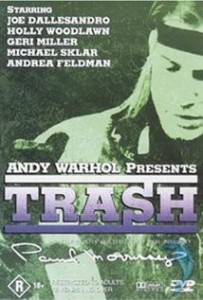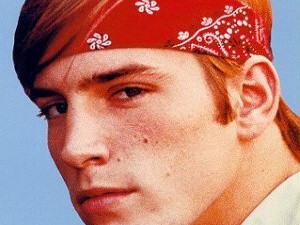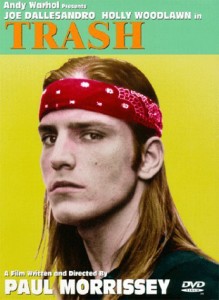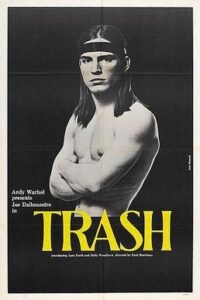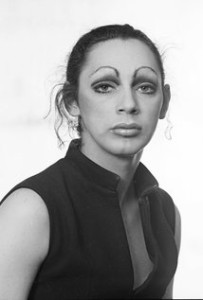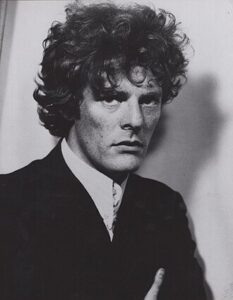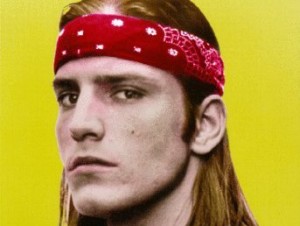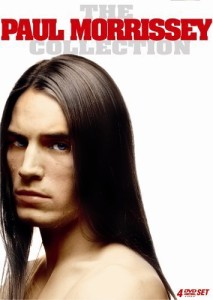Trash *** (1970, Joe Dallesandro, Holly Woodlawn, Geri Miller) – Classic Movie Review 3,136
Paul Morrissey follows up Flesh (1968) for producer Andy Warhol with the 1970 film Trash, a second fresh and funny slice of lowlives drama, again starring Joe Dallesandro as a good-looking lowlife.
Writer-cinematographer-director Paul Morrissey follows up his solo debut Flesh (1968) for producer Andy Warhol with the 1970 film Trash, a second fresh and funny slice of lowlives drama, again starring Joe Dallesandro as a good-looking lowlife.
This time he plays Joe Smith, who is ambivalent about his sexuality and is the object of the amorous intentions of everyone in the movie. But, unfortunately, his drug-addled lifestyle has rendered him incapable of sex. Basically Joe Smith is a heroin addict on a quest to score – more drugs that is rather than sexual partners, whom he frustrates with his impotence.
It is also the story of Joe’s transgender lover/ girlfriend and protector Holly Sandiago (Holly Woodlawn). The duo set up home in a Lower East Side basement, Holly cruises the Fillmore East and scavenges garbage cans, while Joe journeys in search of trash. And Joe gets Holly to fake a pregnancy to try to fool social welfare into approving his methadone treatment.
Morrissey’s sad but hilarious attack on respectable morality is unnerving in its willingness to approach things many people would rather not talk about. Dallesandro is as beautiful and vacant looking as any man can be. The daring and idiosyncratic film flaunts its harsh edges, amateurish status and low production values, which somehow makes it work and also makes it all the more charming.
The film was shot in Morrissey’s basement in New York City in October 1969.
Holly Woodlawn met Andy Warhol at his studio The Factory in Manhattan at a screening of Flesh in 1968 and in October 1969 she was offered the chance of a bit part in Trash the same day her scenes were shot. But she impressed Morrissey so much that he re-wrote her bit part into a much larger role. Woodlawn ad libbed many of her lines and was paid $25 per day for filming, spending the last day’s pay on heroin.
Warhol’s boyfriend Jed Johnson, the film’s editor and sound engineer, recalled: ‘The fact that it all came out as well as it did was because everyone involved with our films is so creative. Paul Morrissey gives a sentence to the actors and has them improvising on a topic while the camera is rolling. No one could write lines like that.’
George Cukor praised Holly Woodlawn’s performance and, supported by others, petitioned the Academy to nominate her for an Oscar, but Gregory Peck said the Academy was undecided whether to nominate the transgender actress for Best Actress or Best Actor, so it didn’t happen. But, after her death in 2015, she was included during the In-Memoriam segment at the 88th Academy Awards.
Teenage model Jane Forth also makes her film debut as Jane. Also in the cast are Geri Miller (returning from Flesh) as Geri the go-go dancer, Bruce Pecheur, Michael Sklar, Andrea Feldman, Diane Podel, John Putnam, and Roberto D’Alessandro.
Future star Sissy Spacek is a barroom extra (uncredited as ‘a girl who sits at the bar’), but her scene was cut out of the final film.
Follow-up: Heat (1972).
Trash opened at Cinema II in New York City on 5 October 1970 and was shown at the London Film Festival in November 1971.
The film features graphic scenes of intravenous drug use, sex and full frontal nudity, and was rejected for a UK cinema certificate in 1971. Hacked to bits, it was passed the following year only in a much shorter form, with heavy distributor and BBFC cuts. It was finally passed completely uncut in the UK in June 2005.
It was a huge success. On a $30,000 budget, it took $3,000,000 at the box office.
The cast are Joe Dallesandro as Joe, Holly Woodlawn as Holly, Jane Forth as Jane, Michael Sklar as Welfare Investigator, Geri Miller as Geri the Go-Go Dancer, Andrea Feldman as Rich Girl, Johnny Putnam [John Putnam] as Boy From Yonkers, Bruce Pecheur as Jane’s Husband, and Diane Podlewski as Holly’s Sister, Diane Podel, and Roberto D’Alessandro.
Holly Woodlawn (October 26, 1946 – December 6, 2015)
Holly Woodlawn died of cancer on December 6, 2015, aged 69. The Puerto Rico-born Warhol superstar appeared in Trash (1970) and Women in Revolt (1971). She took the name Holly from the heroine of Breakfast at Tiffany’s, and added the surname from a sign she saw on TV’s I Love Lucy.
The legendary Lou Reed song ‘Take a Walk on the Wild Side’ refers to Holly, indelibly imprinting her story on American pop culture: ‘Holly came from Miami, F.L.A.; Hitch-hiked her way across the U.S.A. Plucked her eyebrows on the way; Shaved her legs and then he was a she. She says, “Hey, babe, Take a walk on the wild side.”’
Verse 3 of ‘Take a Walk on the Wild Side’ goes:
Little Joe never once gave it away
Everybody had to pay and pay
A hustle here and a hustle there
New York City is the place where they said:
“Hey babe, take a walk on the wild side”
I said, “Hey Joe, take a walk on the wild side”
Paul Joseph Morrissey (February 23, 1938 – October 28, 2024)
© Derek Winnert 2015 Classic Movie Review 3,136
Check out more reviews on http://derekwinnert.com

